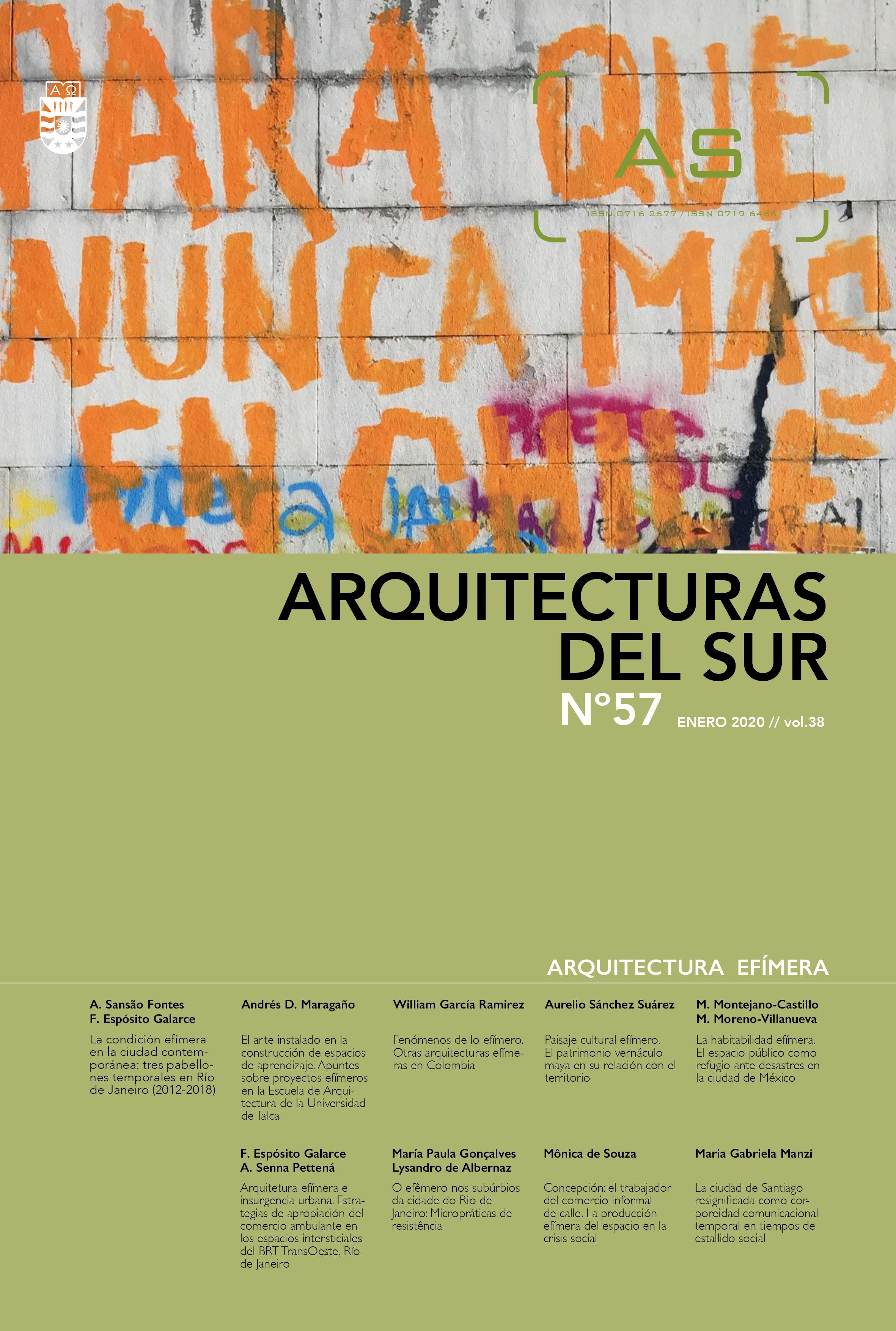Installed art in the construction of learning spaces. Notes on ephemeral projects in the University of Talca’s School of Architecture.
DOI:
https://doi.org/10.22320/07196466.2020.38.057.02Keywords:
installed art, Ephemeral art, construction of knowledge, active learning, architectureAbstract
This paper, looks into the processes and methods of installed art as an artistic proposal that explores its spatiality, participation, an inter-medial nature and which is defined as ephemeral. All these aforementioned characteristics connote it is a space for building knowledge and, from there, a contribution towards the creation of active spaces for learning. There is, in this practice, from its structural processes and developments, a contribution to education, in terms of its procedural, transforming and creative nature. In this way, to undertake this discussion methodologically, the concepts and practices that address installed art and its forms of knowledge production; the academic and social implications that these can contribute and the practice of some ephemeral works carried out at the University of Talca will be connected, where together, it is suggested that these processes seem to favor the acquisition of fundamental aptitudes like: reflection, critical action, participation, cooperation and sensitivity.
Downloads
References
AZNAR, S. (2000). El arte de acción. San Sebastián España: Editorial Nerea, 2000.
BAUDRILLARD, J. Crítica de la economía política del signo, México: Siglo XXI. 1974.
BERTALANFFY, L. (2003). Teoría general de los sistemas. Buenos Aires: Fondo de Cultura Económica. 2003.
BISHOP, C. Introduction, Viewers as Producers. En C. Bishop. (Ed). Participation, 2006, Cambridge, Massachusetts: The MIT Press, pp.10-17.
BISHOP, C. (2008). El arte de la instalación y su legado. Ramona 78 p. 46 - 48 recuperado: https://historiacritica843.files.wordpress.com/2011/09/bishop-instalaciones.pdf
BOURRINAUD, N. Estética relacional, Buenos Aires, Adriana Hidalgo editora. 2006.
DEWEY, J. (2008). El arte como experiencia. Barcelona: Ediciones Paidós. 2008.
DERRIDA, J. La estructura, el signo y el juego en el discurso de las ciencias humanas. 1966. recuperado de: https://mercaba.org/SANLUIS/Filosofia/autores/Contempor%C3%A1nea/derrida/La%20estructura.pdf
HIGGINS, D. “Intermedia”, Something Else Newsletter reprinted with an Appendix by Hannah Higgins, 1965. Leonardo. Vol.34, 2001, pp.49-54
DUARTE, J. Ambientes de Aprendizaje. Una aproximación conceptual. Estudios Pedagógicos, 2003, 29, pp. 97-113. doi: http://dx.doi.org/10.4067/s0718-07052003000100007
FAJARDO, C. Nuevas representaciones artísticas, otros receptores. Aisthesis, 2010, nº 47: pp. 284-295, Instituto de Estética - Pontificia Universidad Católica de Chile
GIROUX, H. Cruzando límites. Trabajadores culturales, y políticas educativas. Barcelona: Ediciones Paidós. 1997.
JOYCE, B. and WEIL, M. Modelos de enseñanza. Madrid, Anaya, 1985.
PERAZA, J. E. Tadashi Kamata constructor de caos. Aitim 2010, 268, pp. 42 – 48, Madrid.
KABAKOV. I. Sobre la instalación total. México. COCOM Press. 2014.
VYGOTSKY, L. Pensamiento y lenguaje. Barcelona: Ediciones Paidós. 1995.
VYGOTSKY. L. Cultura, política y práctica educativa. Barcelona: Editorial Graó. 2001.
ZÚÑIGA, R. La demarcación de los cuerpos, Santiago: Editorial Metales Pesados. 2008.
Downloads
Published
How to Cite
Issue
Section
License
The content of the articles published in each issue of Arquitecturas del Sur is the sole responsibility of the authors and does not necessarily represent the opinion of University of the Bío-Bío.
The authors will maintain their copyright; however, they will guarantee the journal the right to first publication and dissemination of their work. The publication of the article in Arquitecturas del Sur will be subject to the Creative Commons International license (CC BY-SA) that allows others to adapt: remix, transform and build on the material for any purpose, even commercially; share: copy and redistribute the material in any medium or format, as long as the authorship and first publication in this journal are acknowledged by citing them correctly, and their new contributions are under a license with the same terms.














 Programa de Información Científica/Concurso Fondos de Publicación de Revistas Científicas 2018/ Proyecto Mejoramiento de Visibilidad de Revistas UBB (Código:FP180007)
Programa de Información Científica/Concurso Fondos de Publicación de Revistas Científicas 2018/ Proyecto Mejoramiento de Visibilidad de Revistas UBB (Código:FP180007) 
